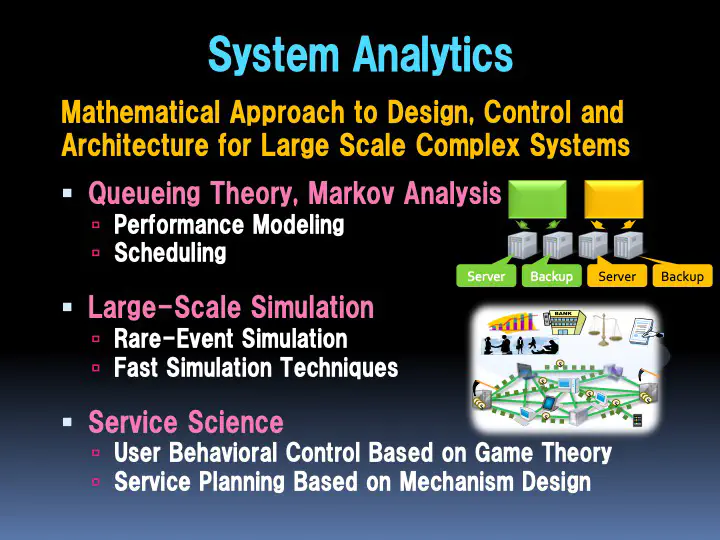System Analytics

Summary
With the knowledge of information science such as applied probability theory, theoretical algorithms, game theory, and mechanism design, we conduct research on system design, control and architectures that realize high-speed, high-reliability, high-performance, and energy-saving characteristics of ultra-large-scale data centers and network systems. From the viewpoint of information network science, we focus on network modeling, network performance evaluation, and network design methods for hazard behavior prediction, hazard control, and trade-off analysis between system safety and hazard management/control in large-scale networked systems. In addition to the Markov chain approach, we also develop deterministic network performance evaluation methods, information flow scheduling methods based on Lyapunov optimization theory, and fast simulation methods for large-scale networks.
Performande Modeling
Based on applied probability theories such as queueing theory, Markov chain, large-deviation, and extreme-value theory, we conduct system-performance analysis, identification of system bottlenecks, parameter tuning, job scheduling and service mechanism, which significantly improve and enhance the system performance. We further conduct computer simulation experiments in order to evaluate the effectiveness and usefulness of our proposed methods, actively aiming to return the developed technologies to the real world.
Blockchain analysis and mechanism design for performance improvement
Bitcoin is a decentralized cryptcurrency system supported by blockchain technology. There is no central authority to manage the minting and circulation of Bitcoin. A key technology of Bitcoin is blockchain, a distributed ledger maintained by all the miner nodes joining Bitcoin peer-to-peer (P2P) network. In Bitcoin system, transactions issued by end users are broadcasted over the P2P network and received by miner nodes. Then, each miner node creates a block from the transactions and starts solving a puzzle-like mathematical problem based on a cryptographic hash algorithm. When a miner node finds its answer, the miner appends the block to the blockchain and receives the reward called coinbase and transaction fees included in the block. The difficulty of the mathematical problem is adjusted automatically such that the block-generation interval is 10 minutes on average.
One of important issues for Bitcoin is scalability. Since the maximum block-size limit is 1 Mbyte and the block-generation time is 10 minutes on average, the number of transactions processed per second (tps) is small and at most seven. In order to make Bitcoin a sustainable ecosystem, incentivisation for miner nodes is indispensable. Since the coinbase is halved every four years, one direction for realizing the Bitcoin ecosystem is designing transaction fees to give incentives for miners to contribute their computation power to maintaining the blockchain.
In order to consider the issues of scalability and incentive mechanism of Bitcoin, quantitative performance analysis of the blockchain plays an important role. Here, we apply queueing theory and game theory to the issues of scalability and miner-user incentivization, analyzing the blockchain performance and developing consensus algorithms such that the resulting blockchain achieves high scalability and tamper resistance under highly decentralized environment.